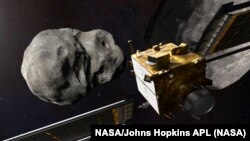NASA successfully crashed its DART spacecraft into a faraway asteroid Monday, in a test of the world’s first planetary defense system. The experiment, designed to avert a potentially catastrophic meteorite collision with Earth, was supported by Australia's national science agency.
The aim was to crash the spacecraft directly into the moonlet hard enough to shift its orbital track around a second, larger asteroid.
It will, however, take days or even weeks to establish how much the smaller asteroid’s path has changed.
Rebecca Allen, from Australia’s Swinburne University’s Center for Astrophysics and Supercomputing, told the Australian Broadcasting Corp. that the mission was a great success.
"It was incredible just because it was, you know, a full bullseye, if we can call it that," she said. "You know, we were expecting maybe it could glance off the side. Is it going to hit exactly where they wanted to and once again NASA does not disappoint with the precision of the impact of the DART spacecraft."
The DART mission has been supported by Australia’s national science agency, CSIRO.
It manages the Canberra Deep Space Communication Complex, one of three stations around the world that make up NASA’s Deep Space Network and was to receive the final signals from the spacecraft as it approached and hit the asteroid known as Dimorphos.
Planetary defense experts have said that altering the course of a menacing asteroid or comet is preferable to blowing it up and creating multiple pieces that could rain down on Earth.
Australian astrophysicist Kirsten Banks said NASA’s DART mission will test our planetary defenses.
"It is going to change the orbit of that asteroid a little bit around the bigger one," she said. "We will be able to see a slight change in the periods, how it takes that little moonlet to orbit around the asteroid and quantitatively measure the effectiveness of this particular method of planetary defense."
The two asteroids that were part of NASA’s DART mission are both very small compared with the asteroid that hit Earth about 66 million years ago, wiping out about 75% of the world's plant and animal species, including the dinosaurs.








